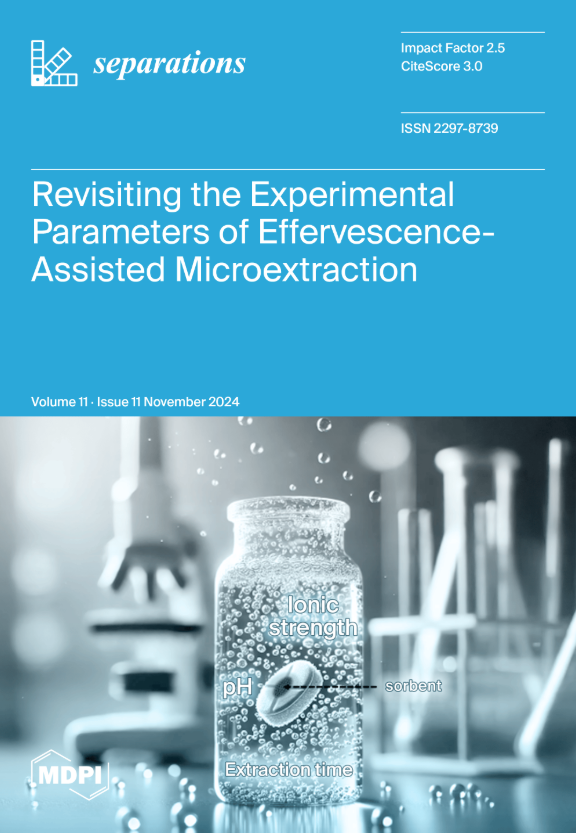Method Development for Aminopyralid Residues Determination by Ultra-High-Performance Liquid Chromatography Coupled to Tandem Mass Spectrometry in Straw
IF 2.7
4区 工程技术
Q3 CHEMISTRY, ANALYTICAL
引用次数: 0
Abstract
Straw is an important by-product of crop production. It has been widely used as a feed as well as in fruit–vegetable production due to exerting a positive impact on soil and crop health and quality in the operated areas. On the other hand, applied crop-specific herbicides throughout the production stage, like aminopyralid (AP), may lead to significant plant injuries in sensitive vegetable plantations, even in very low concentrations. This study aims to optimize a short time, minimal consumables needed, and sensitive extraction and analytical method for AP residues in straw material using LC-MS/MS. For this purpose, standard AP signal response in acetonitrile (MeCN) and 1% of formic acid (FA) in methanol (MeOH) were tested; several chromatographic separation and mass spectroscopy (MS) parameters were improved and optimized. Subsequently, two different extraction methods were performed in AP spiked straw samples, and extraction efficacies were compared. Salting-out assisted liquid–liquid extraction (SALLE) by acidified MeCN combined with final dissolution in MeOH with 1% of FA prior to the analysis was chosen as the most appropriate method for the straw matrix. This method was then used for validation and real sample test analysis. The limit of quantification (LOQ) of AP in this optimized extraction method achieved 10 ng/g straw with a recovery rate of 71% and 13% RSD. The method was also tested on field straw mulch samples and 22.54 ± 0.8 ng/g of AP was detected.利用超高效液相色谱-串联质谱法测定秸秆中氨基吡啶酯残留量的方法开发
秸秆是农作物生产的重要副产品。秸秆被广泛用作饲料和蔬菜水果生产的原料,因为它对操作区的土壤和作物健康及质量有积极影响。另一方面,在整个生产阶段施用作物专用除草剂,如氨基吡啶甲酸盐(AP),即使浓度很低,也可能对敏感的蔬菜种植园造成严重的植物伤害。本研究旨在优化一种时间短、耗材少、灵敏度高的提取和分析方法,利用 LC-MS/MS 对秸秆材料中的 AP 残留进行分析。为此,测试了乙腈(MeCN)和甲醇(MeOH)中 1%甲酸(FA)的标准 AP 信号响应;改进并优化了多个色谱分离和质谱(MS)参数。随后,对添加了 AP 的秸秆样品进行了两种不同的萃取方法,并比较了萃取效果。对于秸秆基质,最合适的方法是采用酸化的 MeCN 进行盐析辅助液液萃取(SALLE),并在分析前用含 1%FA的 MeOH 进行最终溶解。该方法随后被用于验证和实际样品测试分析。在这种优化的提取方法中,AP 的定量限 (LOQ) 为 10 纳克/克秸秆,回收率为 71%,RSD 为 13%。该方法还在田间秸秆地膜样品中进行了测试,检测到了 22.54 ± 0.8 纳克/克的 AP。
本文章由计算机程序翻译,如有差异,请以英文原文为准。
求助全文
约1分钟内获得全文
求助全文
来源期刊

Separations
Chemistry-Analytical Chemistry
CiteScore
3.00
自引率
15.40%
发文量
342
审稿时长
12 weeks
期刊介绍:
Separations (formerly Chromatography, ISSN 2227-9075, CODEN: CHROBV) provides an advanced forum for separation and purification science and technology in all areas of chemical, biological and physical science. It publishes reviews, regular research papers and communications. Our aim is to encourage scientists to publish their experimental and theoretical results in as much detail as possible. There is no restriction on the length of the papers. The full experimental details must be provided so that the results can be reproduced. There are, in addition, unique features of this journal:
Manuscripts regarding research proposals and research ideas will be particularly welcomed.
Electronic files and software regarding the full details of the calculation and experimental procedure, if unable to be published in a normal way, can be deposited as supplementary material.
Manuscripts concerning summaries and surveys on research cooperation and projects (that are funded by national governments) to give information for a broad field of users.
The scope of the journal includes but is not limited to:
Theory and methodology (theory of separation methods, sample preparation, instrumental and column developments, new separation methodologies, etc.)
Equipment and techniques, novel hyphenated analytical solutions (significantly extended by their combination with spectroscopic methods and in particular, mass spectrometry)
Novel analysis approaches and applications to solve analytical challenges which utilize chromatographic separations as a key step in the overall solution
Computational modelling of separations for the purpose of fundamental understanding and/or chromatographic optimization
 求助内容:
求助内容: 应助结果提醒方式:
应助结果提醒方式:


